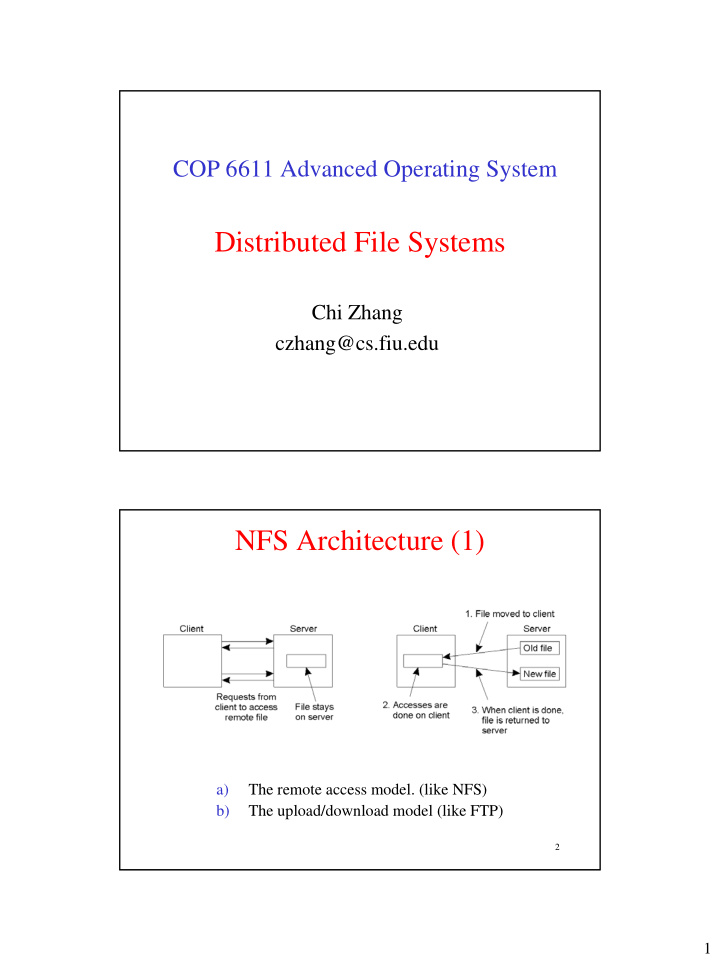



COP 6611 Advanced Operating System Distributed File Systems Chi Zhang czhang@cs.fiu.edu NFS Architecture (1) a) The remote access model. (like NFS) b) The upload/download model (like FTP) 2 1
NFS Architecture (2) The basic NFS architecture for UNIX systems: Hide differences between various file systems (e.g., local vs. remote) 3 File System Model Operation v3 v4 Description Create Yes No Create a regular file Create No Yes Create a nonregular file Link Yes Yes Create a hard link to a file Symlink Yes No Create a symbolic link to a file Mkdir Yes No Create a subdirectory in a given directory Mknod Yes No Create a special file Rename Yes Yes Change the name of a file Rmdir Yes No Remove an empty subdirectory from a directory Open No Yes Open a file Close No Yes Close a file Lookup Yes Yes Look up a file by means of a file name Readdir Yes Yes Read the entries in a directory Readlink Yes Yes Read the path name stored in a symbolic link Getattr Yes Yes Read the attribute values for a file Setattr Yes Yes Set one or more attribute values for a file Read Yes Yes Read the data contained in a file Write Yes Yes Write data to a file An incomplete list of file system operations supported by 4 NFS. 2
Communication: RPC a) Reading data from a file in NFS version 3. b) Reading data using a compound procedure in version 4. (If lookup fails, the succeeding open is not even attempted) 5 Stateful vs. Stateless Servers � NFS v3 is stateless � NSF v4 is stateful � Locking � Authentication � Strict cache consistency � Call back functions 6 3
File Handles � On a local file system, a file descriptor maps to an i- node number. � In NFS, a file handle usually consists of dev number, i- node number and i-node generation number (for i-node reuse, because of client caching) � 64 bytes in v3 and 128 bytes in v4, only makes sense to the server. � Clients lookup the file handle for a given file name under a directory (given by its file handle), and cache the handle locally. � How to get the initial file handle? putrootfh 7 Naming (1) Mounting (part of) a remote file system in NFS. Clients A and B have different paths names for the same file on the 8 server, unless the name space on clients is partly standardized 4
Naming (2) Mounting nested directories from multiple servers in NFS. The client needs to explicitly mount the nested directory, since 9 there is no special file handle that includes the server ID. File Locking in NFS Operation Description Lock Creates a lock for a range of bytes Lockt Test whether a conflicting lock has been granted Locku Remove a lock from a range of bytes Renew Renew the leas on a specified lock NFS version 4 operations related to file locking. Lock operations can be non-blocking (clients have to poll) or blocking. Locks are granted for a specific time ( in case a client crashes). The client needs to renew the lease. 10 5
Semantics of File Sharing (1) a) On a single processor, when a read follows a write , the value returned by the read is the value just written. b) In a distributed system with caching, obsolete values may be returned. 11 Semantics of File Sharing (2) Method Comment UNIX semantics Every operation on a file is instantly visible to all processes Session semantics No changes are visible to other processes until the file is closed. Invalidate the local cache when the file is re-opened later. (NFS) Four ways of dealing with the shared files in a distributed system. Session semantics: propagating updates on cache immediately back to the server is inefficient. Just relax the semantics of file sharing in NFS. If two clients simultaneously cache and modify the file, the final result depends which one closes more recently. 12 6
Client Caching (1) Client-side caching in NFS. Read / Write to the local cache. 13 Client Caching (2) Using the NFS v4 callback mechanism to recall file delegation. The client machine can locally candle open/close operations from other clients on the same machine. The (stateful) server can recall the delegation, for example, when another client on a different machine needs to access the file. 14 7
RPC Failures Each RPC request from a client carries a unique transaction ID (XID). Three situations for handling retransmissions. a) The request is still in progress b) The reply has just been returned 15 c) The reply has been some time ago, but was lost. File locking and Delegation in the Presence of Failures � A lease on every lock to solve client crashes. � After a server recovers from a crash, it enters a grace period , during which new locks are not granted, clients can reclaim locks granted before the crash. � The server rebuilds lock information. � If a client reclaims a file delegation after a server recovers from a crash, the server forces the client to flush all modifications back to the server, effectively recalling the delegation. 16 8
Recommend
More recommend